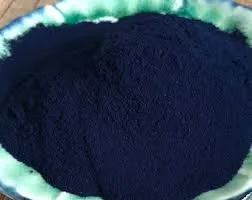Natural Indigo Dye Supplier for Sustainable Textile Production and Eco-Friendly Fabrics
The Journey of Raw Indigo Dye From Nature to Fabric
Indigo dye, with its rich history and vibrant hue, has captivated cultures around the world for centuries. Raw indigo dye, derived from the leaves of the indigo plant, primarily *Indigofera tinctoria*, has seen a resurgence in popularity as both a natural dye and a symbol of sustainable fashion. This article explores the journey of raw indigo dye from its natural sources, through its processing, and into the hands of artisans and manufacturers.
The Origin of Indigo Dye
Indigo dyeing dates back over 6,000 years, with evidence found in ancient Egypt, India, and China. The cultivation of indigo plants began as early as 4000 BC, making it one of the first dyes used by humans. In many cultures, indigo was not only valued for its color but was also associated with various social and spiritual significances. The deep blue obtained from indigo plants has been referred to as the blue of the sky and the color of the deep sea, invoking a sense of mystery and depth.
In recent years, the demand for natural dyes like indigo has surged, driven by a growing awareness of sustainable practices in the textile industry. This shift is largely a response to the environmental impact of synthetic dyes, which are often toxic and harmful to ecosystems. Raw indigo, being a natural product, represents a more eco-friendly alternative.
The Production Process
The journey of raw indigo dye begins with the cultivation of the indigo plant. Farmers meticulously plant and care for these leafy greens, which require a warm climate and well-drained soil. The leaves are harvested when they reach maturity, typically during the summer months.
After harvesting, the process of extracting dye from the leaves begins. The leaves are soaked in water for several hours, allowing the pigment to release into the liquid. This solution is then fermented, which aids in breaking down the plant material and releasing the indigo dye. Following fermentation, the solution is oxidized, leading to the formation of indigo crystals. These crystals are then filtered and dried, producing the raw indigo dye that can be used by manufacturers and artisans.
raw indigo dye manufacturer

The Role of Manufacturers
Raw indigo dye manufacturers play a crucial role in the textile and fashion industries. They take the dried indigo crystals and offer them in various forms, including powders and liquids, suitable for different dyeing techniques. This versatility allows designers and fabric producers to experiment with indigo in various contexts, from traditional hand-dyeing methods to modern industrial processes.
In recent years, many manufacturers have embraced sustainable practices in their production, ensuring that their raw indigo is sourced ethically and produced with minimal environmental impact. This is particularly important in regions where the cultivation of indigo has seen a decline due to industrial farming practices and the rise of synthetic dyes. By supporting local farmers and using traditional dyeing techniques, these manufacturers help revive local economies and promote sustainable livelihoods.
The Impact on Fashion
Fashion designers are increasingly drawn to raw indigo dye for its natural origins and unique aesthetic qualities. The inconsistencies in color that come with natural dyeing processes create garments with a one-of-a-kind appeal, setting them apart from mass-produced clothing. With the rise of slow fashion, there is a growing movement towards unique, handmade items that tell a story—something raw indigo dye embodies perfectly.
As consumers become more conscious of the environmental impact of their choices, the demand for sustainable fashion has skyrocketed. This has led to a renewed interest in traditional indigo dyeing techniques, with artisans and designers collaborating to create contemporary pieces that honor the heritage of indigo dyeing.
Conclusion
The journey of raw indigo dye from plant to fabric is a testament to the blend of nature and craftsmanship that has defined textile culture for millennia. As manufacturers continue to prioritize sustainable practices and promote ethical sourcing, the legacy of indigo dye is likely to endure, bridging the gap between traditional methods and modern fashion. Raw indigo dye is not just a beautiful color; it represents a commitment to the planet and the artistry of those who produce it. Embracing this ancient craft offers a glimpse into a more sustainable future, where fashion and nature coexist harmoniously.
-
The Timeless Art of Denim Indigo Dye
NewsJul.01,2025
-
The Rise of Sulfur Dyed Denim
NewsJul.01,2025
-
The Rich Revival of the Best Indigo Dye
NewsJul.01,2025
-
The Enduring Strength of Sulphur Black
NewsJul.01,2025
-
The Ancient Art of Chinese Indigo Dye
NewsJul.01,2025
-
Industry Power of Indigo
NewsJul.01,2025
-
Black Sulfur is Leading the Next Wave
NewsJul.01,2025

Sulphur Black
1.Name: sulphur black; Sulfur Black; Sulphur Black 1;
2.Structure formula:
3.Molecule formula: C6H4N2O5
4.CAS No.: 1326-82-5
5.HS code: 32041911
6.Product specification:Appearance:black phosphorus flakes; black liquid

Bromo Indigo; Vat Bromo-Indigo; C.I.Vat Blue 5
1.Name: Bromo indigo; Vat bromo-indigo; C.I.Vat blue 5;
2.Structure formula:
3.Molecule formula: C16H6Br4N2O2
4.CAS No.: 2475-31-2
5.HS code: 3204151000 6.Major usage and instruction: Be mainly used to dye cotton fabrics.

Indigo Blue Vat Blue
1.Name: indigo blue,vat blue 1,
2.Structure formula:
3.Molecule formula: C16H10N2O2
4.. CAS No.: 482-89-3
5.Molecule weight: 262.62
6.HS code: 3204151000
7.Major usage and instruction: Be mainly used to dye cotton fabrics.

